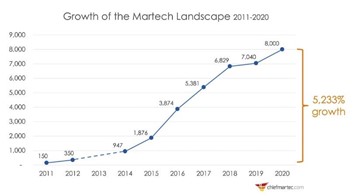“Be present in all things and thankful for all” – Maya Angelou
This Month’s Update:
Rather than wait until the end of the year, we wanted to use our penultimate 2021 Ideal Insights to reflect on where we stand at present. Like every year (and perhaps more so than many others), it was one filled with innovation, evolution, and the recognition that we still have more questions than answers. We have seen the continued explosion of Marketing Technology tools, while many of us scramble to figure out how our marketing execution will survive the impending changes being forced by government regulation and the efforts of the largest tech companies to maintain their position atop the ecosystem.
Chiefmartec.com has been tracking the growth of martech applications over the last decade, estimating a 5+% growth over that time, with the landscape doubling in size in just the last 5 years. But with this growth has come increased complexity and challenges on the side of brands trying to effectively manage their overall marketing tech stack. A 2020 Mulesoft Connectivity Benchmark Report found that the average enterprise has 900 different applications in place, but with an average of only 28% of which are integrated.

Smart Insights has attempted to categorize all the different digital marketing tools in their Smart Insights RACE Planning framework (RACE standing for Reach, Act, Convert, and Engage), and they have found that there are 30 different categories for marketers to be investing in, from Digital Analytics and Content Management tools to E-commerce management and CRM and Measurement tools. Almost all these tools are working to help brands and publishers deliver against the never-ending marketing challenge of right message in the right place at the right time.

What has made this challenge even harder in recent years and a driver behind the proliferation of tools has been the explosion of “right place”. 2021 and the consumer shifts that have occurred as a result of the pandemic and the ensuing supply chain collapses have essentially made it impossible to trust historic results in defining your go forward approach. Consumers are looking to interact directly with brands in almost every media with the unrealistic expectation of knowing their relationship history and product wants while honoring their privacy and messaging frequency expectations. It is certainly a lot for any brand to manage… hence the explosion of tools acting as problem solvers.
What we are now seeing is that brands are starting to recognize that tool complexity has caused them to lose connection with their customers. While the AI driving much of their customer engagement facilitates the process of engagement, it has all become an uncontrolled black box. Marketers are missing the subtle nuances in each touchpoint that often leads to product inspiration and customer loyalty. The insertion of technology third parties between brands and their customers also makes each touchpoint hostage to the pricing and process demands of these third parties.
Brands are starting to recognize that they need to take control of their customer engagements and with that the ability to resolve customer identities and build an enhanced understanding of their customers. They want to manage the technology directly, within their firewalls on the cloud, limiting data security risks and maintaining the flexibility to adjust marketing processes economically as the world continues to shift. Brands must be able to transition as cookies deprecate, privacy regulations expand, and the government and big tech battle out for how they think the ecosystem should operate. For us at Adstra, we welcome the challenge and approach 2022 as a year of opportunity for brands to regain control of their most prized asset, their customer engagement.
Privacy highlights:
House Energy and Commerce Committee Republican Leader Cathy McMorris Rodgers and Republican Leader for Consumer Protection and Commerce Subcommittee Gus Bilirakis introduced a comprehensive legislative draft to establish a national data privacy standard. Each Republican member of the Committee will lead an element of the solutions proposed in the draft. “We note that there are significant areas of agreement in proposals advanced by members of both parties on the core principles to protect all Americans. We encourage members of Congress to come together to reach agreement on a framework that will lead to real privacy protections for consumers – no matter where they live – and establish clear rules of the road that allow for the responsible use of data. We look forward to working with lawmakers in both chambers to make a comprehensive privacy law a reality in the United States,” Privacy for America said in a statement. Politicoand MediaPost covered the introduction.
The Wall Street Journal reported on hurdles that the FTC may face if it proceeds with rule making on data privacy, including budget constraints, personnel changes, and potential legal challenges.
NPRs’ Marketplace looked at the state of tech regulation, including data privacy bills. The Credit Union National Association outlined principles for federal privacy and data security legislation in a letter to a House Financial Services Subcommittee. The group called for any new privacy law to include both
data privacy and data security standards and to keep the Gramm-Leach-Bliley Act intact, among other principles.
Belgium’s data privacy regulator is expected to say in a draft ruling that IAB Europe’s transparency and consent framework violates GDPR, according to the Irish Council on Civil Liberties. “The draft ruling will apparently identify infringements of the GDPR by IAB Europe, but it will also find that those infringements should be capable of being remedied within six months following the issuing of the final ruling, in a process that would involve the APD (Belgian data protection agency) overseeing the execution of an agreed action plan by IAB Europe,” IAB Europe said.
Poytner discussed how U.S. newspapers have evolved their approach to GDPR, with just one of the top ten newspapers by circulation still not offering content to readers in Europe.
Axiosand Wiredexplored the implications of China’s data privacy law for global companies.
The Chinese government ordered 38 apps to rectify what it called excessive collection of personal data.
TechCrunch investigated lobbying on ePrivacy regulations in Europe.
We encourage you to also visit our content blog where you can get the latest news and thoughts on industry issues. While you are there, please also check out our website to gain a clearer understanding of Identity, Data, and all the services we have to offer.
Should you look for more help on these topics, please reach out and we would be happy to help. Email us at connect@adstradata.com

Our insights are again only a small fraction of what is being shared out there. Here are some other interesting articles and opinions we thought to share to both inform and inspire discussion.
100 years ago, we saw the explosion of advertising. With the introduction of radio and the shift to mass production, headed by Henry Ford and his Model T, people turned to marketers to understand what products they should be buying. With Gen Z, this appears to no longer be the case. Trust has been shifted back to word of mouth from word of marketers.
Gen Z prefers people over marketers
We are clearly in a sorting out time again for share of the consumer wallet. With the drop in advertising revenue for many content providers, there has been a race to capture subscription dollars. That battle is hitting a tipping point, however, as consumers look at the number of subscriptions they have signed up for and are starting to say no thanks.
Hunger for new subscribers driving down prices
We all know there has been a tremendous rush to collect 1st Party data, given the perceived concerns around 3rd Party data. From a consumer perspective, the question arises around if there is a real difference. Tracking is tracking as pointed out in Allison Schiff’s article.
1st Party vs 3rd Party: It’s not so black and white
Tony Ayaz does a great job talking to how advertisers should be thinking about managing their marketing programs in a cookieless world. And by getting back to basics and your customer relationship, perhaps the answers will be even better.
Better ad optimization in a cookieless world
PwC research has it right in this article they recently penned. 76% of companies say they lack the ability to transform raw data into actionable insights that could improve customer experiences. CDPs with a strong Identity solution and Data orchestration are key. It is as if they were reading the Adstra playbook.
6 Must have capabilities for your CDP

Positivity Press:
We can all use a little positivity and fun in life. Here are some of the recent items we wanted to share with everyone:
It’s Thanksgiving time and for all the challenges the pandemic has brought us, there is still a lot we can all be thankful for. Gratitude is a wonderful step to a better life for all.
300 Things to be thankful for in 2021
As fall slips by, it is time to start thinking about the winter. Snow and cold are on their way, and it will be harder to hang outside. But if you plan ahead there are still a ton of fun to be had with your kids. Enjoy them.
20 Fun things to do with kids in winter
We have taken you here before, but we always enjoy catching up on the great news shared on The Good News Network. From turning old tires into beds for stray cats and dogs to the rebirth of the river Thames, there is always a story to cheer you up.
A lot of new inventions out there in 2021 and Time has done a great job of selecting the best 100 for us. How many are you aware of?
We continue to strive to provide useful, fun, and actionable info that can help us all in some way. Feel free to share feedback and ideas and we can share them with this community. As always, be healthy and happy.



